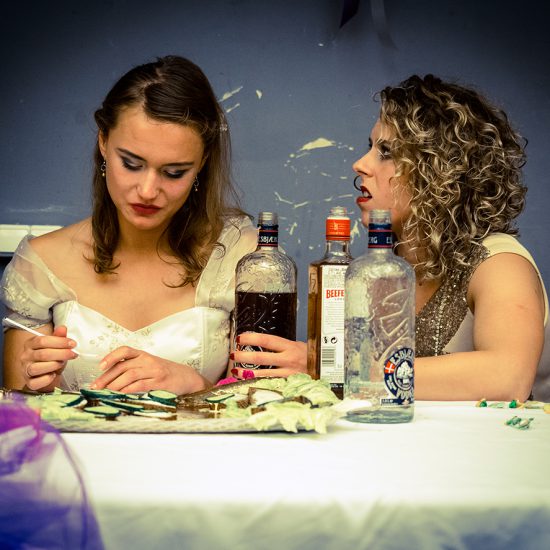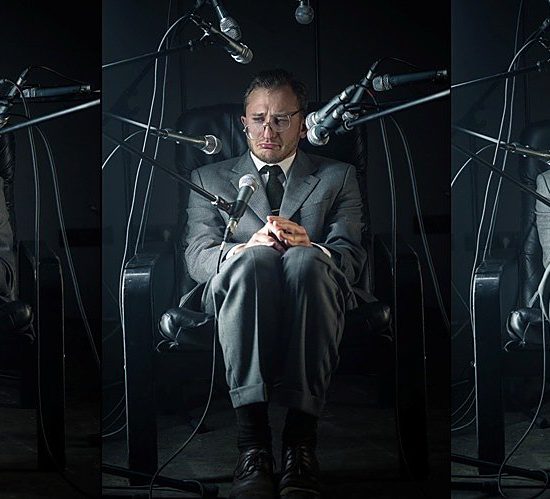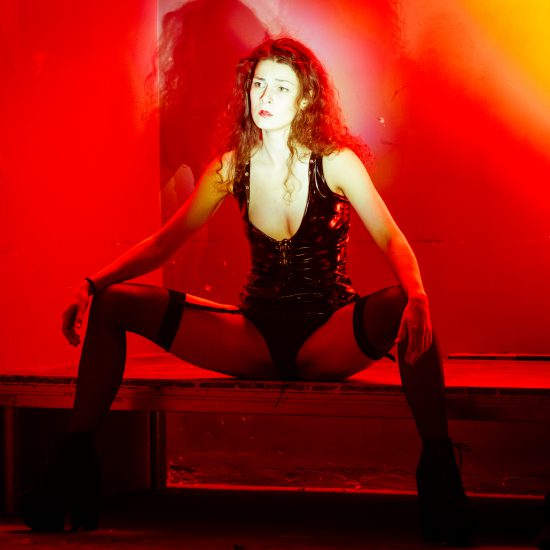Theatre – death
For Oskaras Koršunovas, the world of “Hamlet” is a world of theatre and tragic clownery.
The residents of the Danish king’s castle live in the uneasy twilight of the stage, they are hypocritical and ready to identify with any role at any time. Their lives’ ways resembles a maze; for them only the bloody finale brings the true revelation, but in its face there’s nothing more to say, except “The rest is silence.”
We may say the world has gotten too absorbed in playing.
Koršunovas puts a dozen make-up tables on the stage; they roll and move around the stage, and are constantly arranged and re-arranged into different geometric shapes. They look like Chukovsky’s moidodyrs and are no less brutal.
Mirrors, creating multiple reflections of each other, terribly sharp and irritating sound, fluorescent lamps over the mirrors radiating a cloud of uncomfortable “heat” of the unpleasant and toxic world, the process of applying make-up and that of wiping it off…
When used by Koršunovas, this simple metatheatrical magic is intense, extreme and highly effective.
For example, the mechanism of the make-up tables works similarly to the famous curtain designed by David Borovsky for Liubimov’s “Hamlet” – a thick crocheted curtain, “walked” on the stage crushing and wiping out the characters, like the fierce mechanics of merciless fate.
And another example: when saying the monologue of Claudius, actor Dainius Gavenonis arranges the mirrors and his arms in such a manner that to Hamlet he resembles a monstrous spider with hideously moving legs reflected in the mirrors.
The performance begins with all the actors sitting with their backs to the audience and applying make-up. We only see their quiet, indifferent faces reflected in the mirrors. This ritual, like silence before the storm, gradually changes to a whisper, and then – to a scream.
The actors, putting on their white masks of “death” look into their worn out faces and, addressing themselves in the mirror, sarcastically utter one phrase: “Who are you?”
This crisis of self-identity evolves into hysteria.
Who are you, my other dyad, there in the mirror?
Who are you, my look-alike?
Which one is the real me?
Who am I without make-up?
”Hamlet”, the most important play of Christian humanity, has always given grounds for solving the “final issues” with Hamlet’s character epitomizing the modern hero, full of self-irony and sarcasm, doubtful and prone to self-destruction.
In “Hamlet”, the audience has to look at itself as if looking in the mirror – such is the centuries-old magic of the play. Oskaras Koršunovas’s Hamlet, who started with the question “Who are you?” finishes with a clear response: “You are a murderer.”
Darius Meškauskas plays Hamlet. In his early forties, the actor is extremely strong, with surprising and expressive face. In his tired and suffering face innocence merges with fear.
This Hamlet’s face is a face of a forever intimidated man. A man who saw something that petrified him, made him old in the wink of an eye, and tied him to a single image forever.
This Hamlet is forever fascinated and obsessed with the image of death and its premonition. Meeting his father’s ghost turned him into a ghost, cursed to roam about the earth with a single purpose – to defeat evil, and revenge.
Hamlet’s father appears before his son like a corpse in a neon purple-lit morgue – the corpse takes Hamlet by the throat, strangles him, stuffing the words of revenge into Hamlet’s mouth, and dies again.
No tenderness, no sense of justice, no fatherly feelings – just poison and retribution.
A dead person appeals to a living one, so he can repay his debts.
The deceased breathes the air of death and destruction into the lungs of his living son, and freezes his gaze.
This play is about death.
At a certain moment the whole stage is surrounded by white lilies – the flowers of death. It is in white lilies that Ophelia will drown, like in a river.
In the final scene, Gertrude, wishing to taste the deadly wine, gets lost in the passionate kiss with Yorick’s skull, as if she’s ready to plunge into the grave.
In “Hamlet”, Koršunovas reveals the brutal secret of death, half-opens the door to the crypt, filling the aura of the performance with slow and viscous waters of Styx, and its putrid smell.
At the end, Hamlet stands before us, his face covered in blood, and roars out, as if in agony, the “to be or not to be” monologue.
The man who becomes a killer of the guilty as well as the innocent at the volition of the dead admits his refusal to act. The meaning of the words spoken “out of place” suddenly opens up.
<…>
The object of Hamlet’s guilt – Ophelia (played by Koršunovas’ favorite actress Rasa Samuolytė). Surrounded by white lilies (a symbol of death as well as the manifestation of the Madonna), Ophelia, dressed in a white Japanese-style garment is the embodiment of innocence.
She is another forever terrified creature in this “Hamlet” – Ophelia yearns for love, care, tenderness, a child, a sacrament, the guardian angel.
Visions and torments of false pregnancy will haunt Ophelia until her lonely and innocent world of an unloved child is crushed by the anger and meaninglessness of the cruel world.
This little angel, who has accidentally strayed into the militarized world, goes mad when she suddenly notices how calmly Claudius sends Hamlet to death. The father’s death is not the only condition for her to lose a sense of reality.
Oskaras Koršunovas does use metatheatrical tools – make-up tables. I am talking about the mystery of the theater, as a metaphor of death or a deadly dream.
By applying make-up to their faces, the actors sort of mummify themselves, and Hamlet, who chose the play as a form of revenge to Claudius, enters the path of death at that very moment.
The mirror, as a theatrical stunt, a symbol of the image that the actor “dives” into before the start of the play (Who are you?), is also associated with death – the afterlife that mocks us from the other side of the mirror.
The actors first put on white ghastly make-up, and then, as if struck by an epiphany, wipe it off with special tissues. For Koršunovas, this gesture of refusal to wear make-up, the shedding of all that is unnecessary, becomes a step towards reality, a conversion, and purification.
Hamlet wipes off the make-up from his face as deadly sweat after the meeting with his father, when everything becomes so clear, so extremely transparent. The floor becomes covered with used wipes – white, delicate, and torn.
In the mousetrap scene, at the moment of triumph, Hamlet peppers the stage with similar tissues, only this time they are red; in a frenzy he throws them on different parts of the stage, like blood clots, flowers of evil or autumn leaves.
At that moment, the Lithuanian “Hamlet” is like a Japanese film with autumn mountain maples, which cause both admiration and distress.



